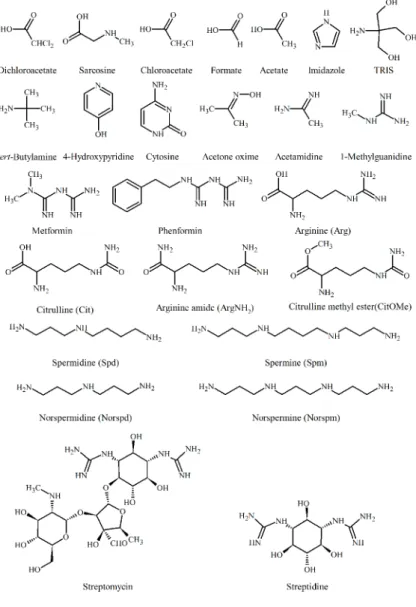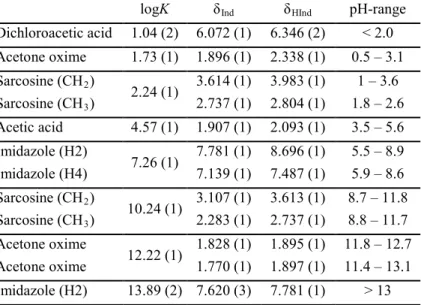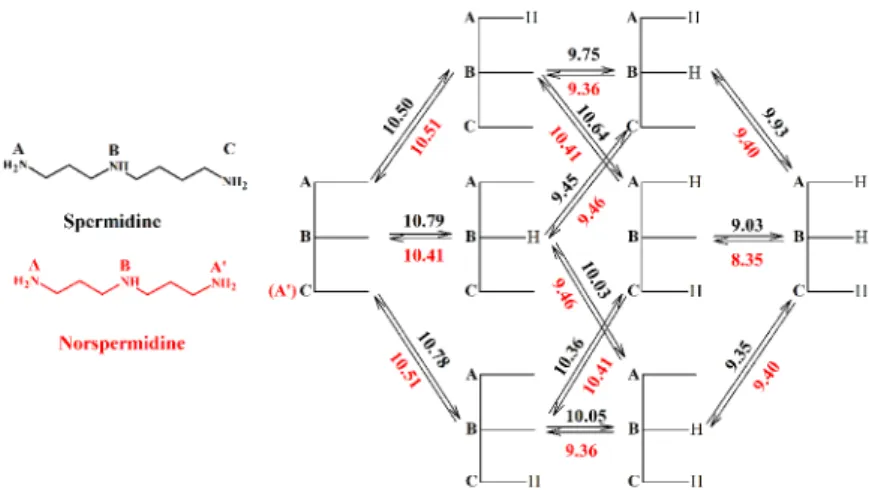Characterization of highly basic molecules in terms of site-specific protonation parameters
Theses of doctoral (PhD) dissertation Gábor Orgován
Semmelweis University
Doctoral School of Pharmaceutical and Pharmacological Sciences
Supervisor: Prof. Dr. Béla Noszál, D.Sc.
Opponents: Dr. Ádám Demeter, Ph.D.
Dr. Tamás Tábi, Ph.D.
Head of examination committee: Prof. Dr. György Bagdy, D.Sc.
Members of examination committee: Prof. Dr. Pál Perjési, C.Sc.
Prof. Dr. Huba Kalász, D.Sc.
Semmelweis University
Department of Pharmaceutical Chemistry
1. Introduction
Most bio- and drug molecules contain two or more basic sites. The fate of ionizable drug molecules in the body (pharmacokinetic parameters) depends on external parameters (pH, temperature, relative permittivity, extramolecular environment), and also internal ones, such as molecular structure, lipophilicity, charge and charge distribution. Latters are influenced and can be characterized by various acid-base parameters, e.g.
protonation constant (logK).
Knowledge of these values are of high importance in every stage of drug development. In regulatory processes the protonation constants need to be determined with high precision.
Binding of drug molecules to the target depends not only on their gross charge. Rather, it is highly affected by the protonation state of ionoizable groups. Site-specific basicities can be quantified by the microscopic protonation constants, which provide information on their submolecular basicity.
Microconstants can be determined either by a pH-dependent, group- specific spectroscopical method or by transferring basicities of structurally related analogues.
A large number of biologically and pharmaceutically important compounds contain strongly basic functional groups (e,g. guanidino, amidine). The protonation of these groups takes place in strongly basic media, where the accurate pH-determination is a difficult task.
In fact, most literature protonation constants on very basic molecules are highly erroneous, due to the distorted pH determination near the upper end of the pH-scale.
We have therefore elaborated an NMR-based pH determination method that provide correct acidity data in highly basic solutions. This method allowed the determination of logK values for molecules that could not be
2. Objectives
The aim of this work was the determination of macroscopic and microscopic protonation constants of molecules of high biological/pharmaceutical importance and strong basicity. Our studies have unfortunately showed that most literature logK values were incorrect, mainly due to the lack of an accurate pH-determination method.
To quantify these equilibria a method for the accurate determination of extremely high pH values was needed. Our aim was to develop a 1H NMR method, in which pH can be accurately calculated from chemical shifts of indicator molecules throughout the pH-scale (0–14).
A subsequent aim was to accurately determine the microscopic protonation constants of the most basic natural amino acid, arginine, by 1H NMR-pH titrations. Calculation of the microconstants could be achieved by including auxiliary compounds and deductive methods. The structure of the molecules are shown on Figure 1.
We also investigated the protonation processes, in particular, the group- specific basicities of the guanidino groups, of streptomycin, the classical aminoglycoside antibiotic drug (Figure 1). Introducing streptidine (Figure 1), the only available model compound, we were able to quantify the protonation processes of the major streptomycin microspecies.
Furthermore, we have also aimed at developing a 15N NMR method for the determination of group-specific basicities of individual amino groups.
This method enabled us to determine the microconstants of linear biological polyamines and their nor-derivatives (Figure 1), a family of compounds that play a crucial rule in the regulation of the cell cycle.
Figure 1. Structure of the studied molecules
3. Methods
All the measurements were carried out at 25 °C. The ionic strength was adjusted to a constant value (1.00 M or 0.15 M) by an inert salt, KCl. The concentration of the molecules were: 0.5 – 2.0 mM indicator molecules (dichloroacetic acid, acetone oxime, sarcosine, chloroacetic acid, formic acid, acetic acid, imidazole, TRIS, tert-butylamine, cytosine, methylguanidine, Figure 1); 2 mM biguanides (metformin, phenformin); 5 mM arginine and model compounds (arginine, citrulline, arginine amide, citrulline methyl ester), 5 mM streptidine, 20 mM streptomycin, 50 mM polyamines (spermidine, spermine, norspermidine, norspermine).
NMR-pH titrations. Titrations were carried out on a Varian Unity 600 MHz spectrometer. The solution contained 5 % (v/v) D2O. Water resonance signal was suppressed by double spin echo or presaturation pulses. pH of the samples was measured by a Metrohm 6.0234.110 combined glass electrode and/or calculated from chemical shifts of indicator molecules.
1H NMR spectra were recorded in the titrations of the indicator molecules, arginine and model compounds and the biguanides. The chemical shifts of the overlapping proton signals of streptidine and streptomycin were determined by 13C HSQC titrations. The hydrogen chemical shifts of polyamines were measured by 1H and if needed, 13C HSQC spectra, while 15N HMBC measurements were carried out for the determination of nitrogen chemical shifts. Titration curves were evaluated by the OriginPro 8.0 software.
Potentiometric titrations. pH-metric titrations were performed using a Metrohm 6.0234.110 combined glass electrode attached to a Metrohm 716 DMS Titrino autoburette, at constant ionic strength (1.00 M). For the determination of macroconstants acidified solution of 50 mM polyamine was titrated with KOH solution. The simultaneous evaluation of potentiometric and NMR-pH titrations were done by OriginPro 8.0 software.
4. Results, new scientific statements
1. A 1H NMR-based pH-determination method was developed. By this method the pH can be precisely and accurately determined in the entire (0–14) pH-range. The indicator parameters of the indicator molecules were determined at the two most often applied ionic strengths (0.15 M and 1.00 M). The results showed that pH can be determined by five indicator molecules (dichloroacetic acid, acetone oxime, sarcosine, acetic acid and imidazole) in the whole pH-range, at 1.00 M ionic strength. The useful pH-range was calculated by keeping the maximal error or pH-determination at 0.03 log units (Table 1).
Table 1. The most important indicator parameters and the useful pH- range of the selected indicator molecules.
logK δInd δHInd pH-range Dichloroacetic acid 1.04 (2) 6.072 (1) 6.346 (2) < 2.0 Acetone oxime 1.73 (1) 1.896 (1) 2.338 (1) 0.5 – 3.1 Sarcosine (CH2)
2.24 (1) 3.614 (1) 3.983 (1) 1 – 3.6 Sarcosine (CH3) 2.737 (1) 2.804 (1) 1.8 – 2.6 Acetic acid 4.57 (1) 1.907 (1) 2.093 (1) 3.5 – 5.6 Imidazole (H2)
7.26 (1) 7.781 (1) 8.696 (1) 5.5 – 8.9 Imidazole (H4) 7.139 (1) 7.487 (1) 5.9 – 8.6 Sarcosine (CH2)
10.24 (1) 3.107 (1) 3.613 (1) 8.7 – 11.8 Sarcosine (CH3) 2.283 (1) 2.737 (1) 8.8 – 11.7 Acetone oxime
12.22 (1) 1.828 (1) 1.895 (1) 11.8 – 12.7 Acetone oxime 1.770 (1) 1.897 (1) 11.4 – 13.1 Imidazole (H2) 13.89 (2) 7.620 (3) 7.781 (1) > 13 This series of indicator molecules makes possible the accurate measurement of extremely high pH values and the subsequent determination of protonation constants of strongly basic molecules.
2. The protonation constants of two strongly basic biguanide-type oral antidiabetics, metformin and phenformin were determined. We have shown, that the logK1 values found in the literature are significantly lower than our protonation constant.
Table 2. Protonation constants of biguanides logK1 logK2
Metformin 13.85 ± 0.03 3.14 ± 0.02 Phenformin 13.27 ± 0.03 3.26 ± 0.02
3. The microconstants of arginine, the most basic natural amino acid were determined by combining the accurate NMR-pH titrations and the deductive method. The molecule contains three basic sites: a guanidino (G), a primary amino (A) and a carboxylate (C) moiety (Figure 2).
Inherent basicities of these groups are well-known to be different, the microconstants can therefore be calculated by deductive method, since the abundance of the minor species is lower by several orders of magnitude. We chose two isoelectronic model compounds, which contain a reduced number of ionizable groups: citrulline and arginine amide. The calculations were validated with an independent experiment:
the adequate microconstant of arginine was compared to the macroconstant of citrulline methyl ester, a close derivative. The constants are in good agreement.
The literature value of logK1 falls as much as one log unit below than our constant, thus the isoelectric point is higher (11,41). The isoelectric point of citrulline is 5,5 log units lower (5,91), which is so far the largest difference between two isoelectronic compounds.
The results showed that the major species predominate over the minor ones by 5 and 10 orders of magnitude.
Figure 2. Microscopic protonation scheme and constants of arginine 4. The protonation constants of streptomycin, the first-discoverd
aminoglycoside-type antibiotic drug and its aglycone, streptidine were determined. The molecules contain three and two ionizable groups, respectively (two guanidino and a secondary amino; and two guanidino).
The pair interactivity parameter between the two guanidino groups was determined for the first time. The value is significantly lower than the interactivity parameter between the amino groups of 1,3- diaminopropane-type compounds. This phenomenon can be interpreted as the charge on the protonated guanidino group is located near the
“remote” nitrogen to a large extent, Due to the extensive delocalization, however, the charge cannot be assigned to a particular nitrogen atom.
The site specific basicities of the streptomycin guanidino groups were calculated by transferring the interactivity parameter of streptidine. The guanidino group in position 1 is twice as basic as the sterically hindered G3 group (Figure 3). Streptomycin is so strong base that 25 % of the molecules are still protonated even in 1 M NaOH solution.
Figure 3. The major protonation pathways and related constants of streptomycin.
5. The macro- and microconstants of two linear triamines (spermidine and norspermidine, Figure 4) and two tetraamines (spermine and norspermine Figure 5). The macroconstants were determined by the simultaneous evaluation of potentiometric and 1H NMR-pH titrations. In order to calculate the microconstants 15N NMR-pH titrations were carried out. Literature values have been reported on the basis of 13C NMR-pH titrations, but the reliability of these results is questionable, since the basic sites are very close, the chemical shifts of the carbons adjacent to the amino groups are therefore not at all selective indicators of the site-specific protonation.
The microconstants of the minor species, however, cannot be determined accurately from the 15N NMR-pH titration curves, as their contribution to the analytical signal is negligible. We have therefore used the deductive method: we transferred the interactivity parameter of a model compound with reduced number of ionizable groups.
All the microconstants of the tetraamines cannot be calculated from the experimental data, by principle, two additional pieces of information are needed. We have, therefore, transferred the adequate pair interactivity parameters of spermidine and norspermidine, thus the microconstants could be calculated.
Figure 4. Protonation scheme and microconstants of spermidine and norspermidine
Figure 5: Protonation scheme and microconstants of spermine and norspermine
Among the protonation isomers those are of higher abundance, where the positive charges are more separated. In case of diprotonated isomers those are AA’ and AB’ species, while for the triprotonated ones, the ABA’ species.
6. The standard error of the microconstants was calculated using the quadratic error propagation rule of Gauss. It was shown that one can get reliable microconstants by deductive methods, if the model compound corresponds to the minor species. By selectively monitoring the basic sites, the concentration of the microspecies have to be comparable to get the microconstants with reasonable standard deviation.
5. Summary
A new 1H NMR-based method was developed for the accurate determination of high pH values. This series of indicator molecules made possible the accurate determination of microscopic and macroscopic protonation constants of molecules of high basicity and biological/pharmaceutical importance.
The protonation constants of two strongly basic biguanide-type oral antidiabetics, metformin and phenformin were determined.
All the microconstants of the most basic natural amino acid, arginine were calculated by combination of NMR-pH and deductive method.
Protonation constants of streptomycin, an aminoglycoside type antibiotic drug containing two guanidino groups, were determined. The pair interactivity parameter between two guanidino groups was also calculated.
The microconstants of two triamines and two tetraamines were determined by 15N NMR-pH titrations, by using as few deductive elements as possible.
The standard errors of the microconstants were quantified by the error propagation rule of Gauss.
6. Publications
Papers of the thesis work
1. Orgován G., Noszál B. (2011) Electrodeless, accurate pH determination in highly basic media using a new set of 1H NMR pH indicators. J. Pharm. Biomed. Anal. 54 (5):958-964.
2. Orgován G., Noszál B. (2011) The complete microspeciation of arginine and citrulline. J. Pharm. Biomed. Anal. 54 (5):965-971.
Related papers
1. Orgován G., Tihanyi K., Noszál B. (2009) NMR analysis, protonation equilibria and decomposition kinetics of tolperisone. J.
Pharm. Biomed. Anal. 50 (5):718-723.
2. Orgován G., Noszál B. (2011) Transporterization: a tool for drug delivery. In: Tihanyi K., Vastag M. (eds) Solubility, Delivery and ADME problems of drugs and drug-candidates. Bentham Science Publishers, accepted for publication.




